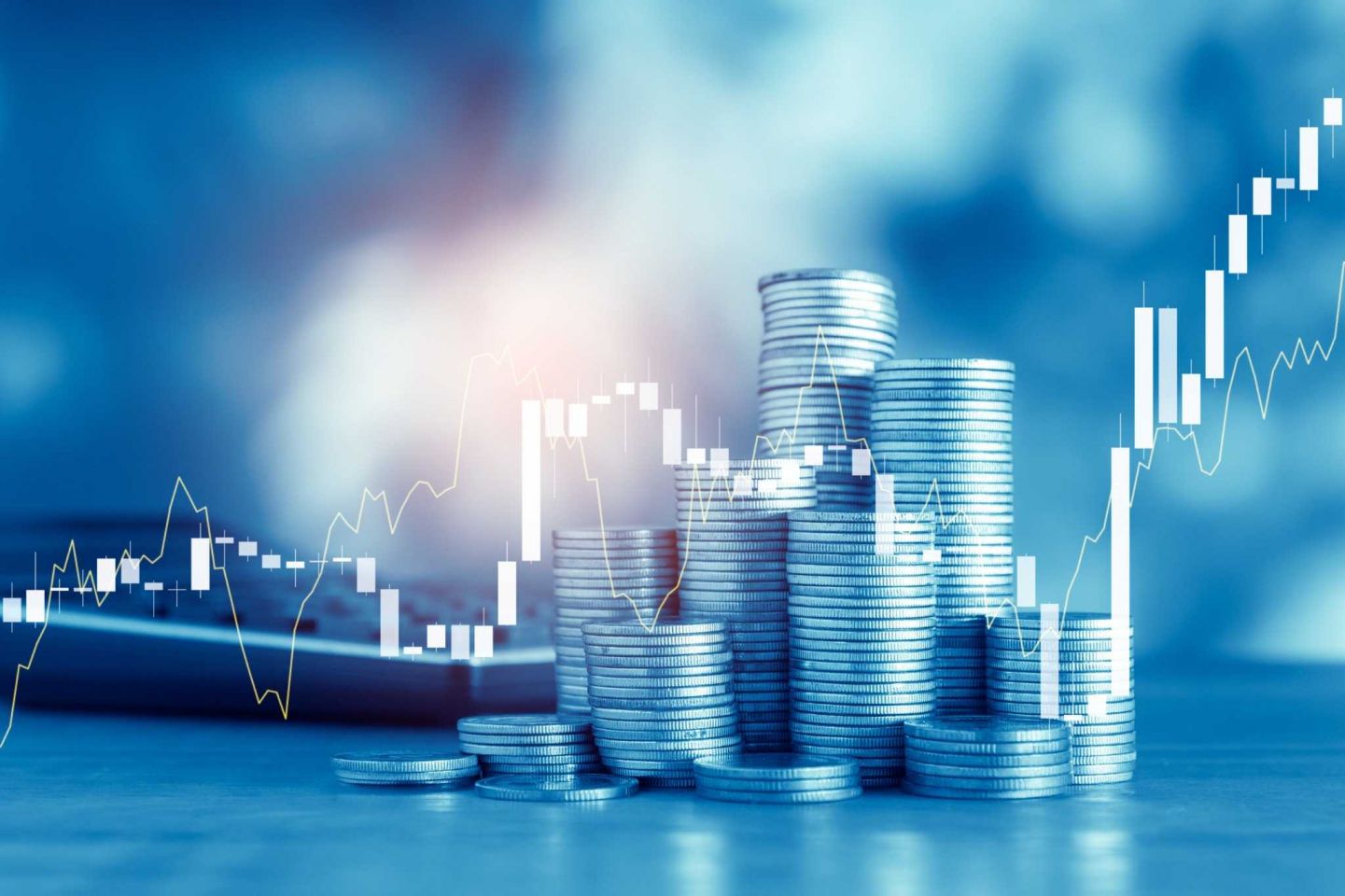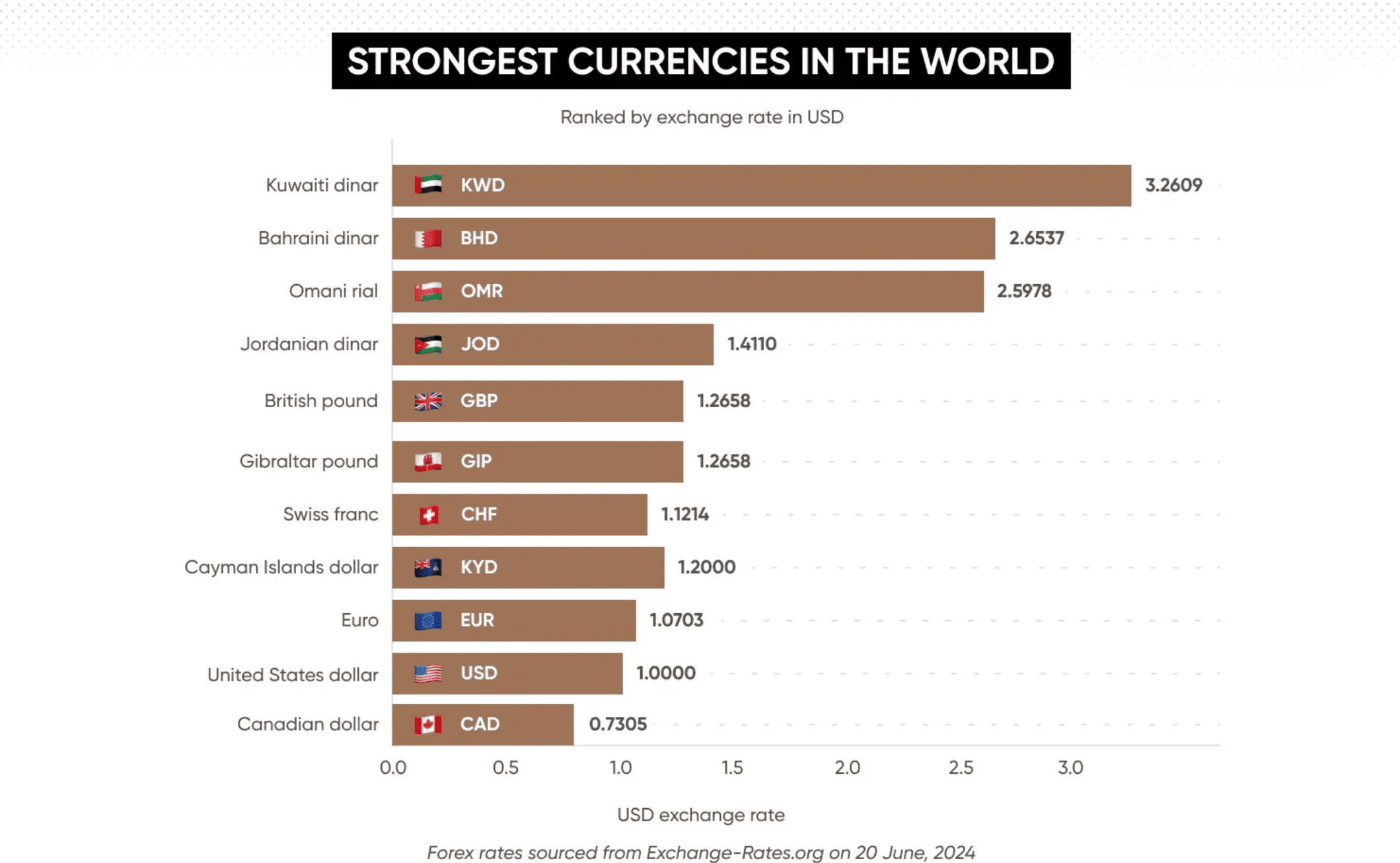Strongest currencies in the world

The strongest currencies in the world are those which have the greatest value. A currency’s value is determined by its supply and demand, which can be influenced by commodities, economic performance, and political stability.
When discussing the ‘strength’ of a world currency, we’re talking about its relative value on the forex market against the US dollar.
Forex trading is the biggest financial market in the world, so you might be interested in what makes a currency strong and how major currencies from the world’s leading economies measure up against each other.
Top 10 strongest currencies in the world
The United Nations recognises 180 currencies as legal tender, covering 195 countries. Here are the top 10 strongest currencies in the world, ranked by their value compared to the US dollar as of 24 June 2024*:

Past performance does not guarantee future results.
Kuwaiti dinar (KWD)
Established in 1960, Kuwait’s national currency is the strongest and most valuable currency in the world – and it’s been that way for several decades.
Large natural oil reserves, high demand on the forex market, and a limited currency supply contribute to the Kuwaiti dinar’s strength. 90% of Kuwait’s state revenue is generated from oil exports – so long as there is a global demand for oil and an ample supply in the country, demand for the Kuwaiti dinar will also be high.
The Kuwaiti dinar is pegged to a basket of currencies rather than a single currency peg.
Bahraini dinar (BHD)
Like Kuwait, Bahrain gets a large proportion of its revenue from one commodity. 70% of government revenue is made from oil exports. Bahrain’s wealth of oil helps drive market demand for the Bahraini dinar.
The Bahraini dinar, which replaced the Gulf rupee as Bahrain’s national currency in 1965, was pegged to the US dollar in 1980 at BHD 1 to USD 2.65. The BHD-USD currency peg contributes to market confidence, low volatility and currency strength.
Omani rial (OMR)
Introduced in 1970, the Omani rial introduced a currency peg to the US dollar in 1973. The Omani rial was originally pegged at OMR 1 to USD 2.895 until it was adjusted in 1986 to a rate which it has kept since.
The peg is OMR 1 to USD 2.6008.
Oman earns much of its national currency strength from the demand and revenue generated from its oil and gas production and exports. Oman’s trade relations with the United States and its economic stability add to the strength of the Omani rial.
Jordanian dinar (JOD)
The Jordanian dinar has been in use since 1950, and in 1995, the government of Jordan pegged the Jordanian dinar to the US dollar in 1995 at a rate of JOD 1 to USD 1.4104.
Despite a relatively low dependence on oil and gas exports compared to other Middle Eastern countries in this list, Jordan’s national currency is the fourth-strongest currency in the world.
Its strength can be attributed to the country’s open market policies, currency scarcity, and large foreign exchange reserves.
British pound sterling (GBP)
British pound sterling is the world’s oldest currency still in use today. The history, credibility and stability of the British financial system and the Bank of England, as well as the nation’s economic strength and London’s presence as a major financial hub give the pound strength, making it one of the most valuable currencies in the world.
The British pound is also part of one of the most popular currency pairs – GBP/USD, also known as ‘cable’. The nickname originated in the 19th Century, when foreign exchange rates were transmitted by transatlantic underwater telegraph cables.
Gibraltar pound (GIP)
The Gibraltar pound was introduced after the Spanish Civil War in 1896, replacing the Spanish ‘real de plata’ and the official currency of Gibraltar.
The stability of the currency is secured with a 1:1 peg to the British pound sterling, so one GIP is always equal to one GBP.
Swiss franc (CHF)
Switzerland’s Swiss franc is the official legal tender of both Switzerland and Liechtenstein.
The national currency has garnered a ‘safe haven’ label that attracts some traders during times of geopolitical or market uncertainty. Switzerland has USD 1,033 billion in foreign currency reserves, which makes it the country with the third-largest foreign currency reserve assets in the world behind China and Japan.
Those reserves make the Swiss Franc the sixth strongest currency in the world, alongside Switzerland’s political and economic stability and large trade surplus.
Cayman Islands dollar (KYD)
The Cayman Islands is a major international offshore financial centre with one of the strongest currencies in the world. This comes as a result of its large financial services sector, tourism industry and ‘safe haven’ status, which attracts many major banks and corporations to the country.
In 2019, the Cayman Islands generated 40.2% of its GDP from financial services and according to KPMG, 43 of the 50 largest banks in the world have business operations in the Cayman Islands.
The Cayman Islands dollar was introduced in 1971 and replaced the Jamaican dollar as the country’s currency. The Cayman Islands dollar is pegged to the US dollar at a fixed rate of 1 Cayman Islands dollar to 1.2 US dollars.
Euro (EUR)
The euro is the official currency of 20 out of the 26 EU member countries, with a combined population of almost 350 million as of January 2023. The EU is the world's largest single market area with the third largest economy, making up one sixth of global trade. Growth of this economy which includes a large trade surplus adds to the value of the Euro on the foreign exchange market.
The most traded forex pair in the world includes the Euro, it’s EUR/USD, and it’s nicknamed ‘Fiber’.
US dollar (USD)
The US dollar is the national currency of the United States and 16 other countries and territories including Ecuador, El Salvador, Puerto Rico, Zimbabwe, and Panama. The United States dollar is the most widely traded currency in the world, it’s used as a currency peg for many countries' national currencies, and it’s the world’s largest reserve currency.
The strength of the US dollar is supported by economic growth (the United States is the largest economy globally). On the other hand, rising commodity prices, overvaluation and economic growth in rival markets negatively impact the US dollar’s strength.
The US dollar is a common benchmark for measuring the performance of other currencies, like we have done in this list.
Canadian dollar (CAD)
The Canadian dollar is considered a ‘commodity currency’, as its value usually correlates with the price of its export commodities, namely crude oil. In fact, Canada is the fifth-largest exporter of crude oil in the world.
Canada’s commodity exports, along with its healthy economic growth contribute to the Canadian dollar being one of the world’s strongest currencies.
CAD/USD is one of the most frequently traded currency pairs, commonly nicknamed the ‘loonie’ after the common loon bird depicted on the Canadian one-dollar coin since 1987.
If you want to master forex trading try our step-by-step forex course and explore potential profits and losses on your forex CFD trades with our free forex profit calculator.
FAQ
What is the most valuable currency in the world?
The Kuwaiti dinar (KWD) is the most valuable currency in the world at the time of writing, followed by the Bahraini dinar (BHD) and the Omani Rial (OMR).
A currency's value can go up or down, and can be influenced by both local and macroeconomic factors, such as the relative strength of other economies. There are other factors to consider when determining a currency’s strength as a tradeable asset such as liquidity and volatility.
What is the weakest currency?
Currency values change constantly, so it's important to do your own research in determining the weakest currency in the world. As of writing, the weakest currency in the world (as measured against the US dollar) is the Lebanese pound (LBP). Some of the weakest currencies include the Iranian rial (IRR), the Vietnamese dong (VND) and the Lebanese pound (LBP). Source: Forbes.com.